#AttributionModeling
Explore tagged Tumblr posts
Text
Marketing Ninja Secrets: Unlock the Power of Attribution Modeling
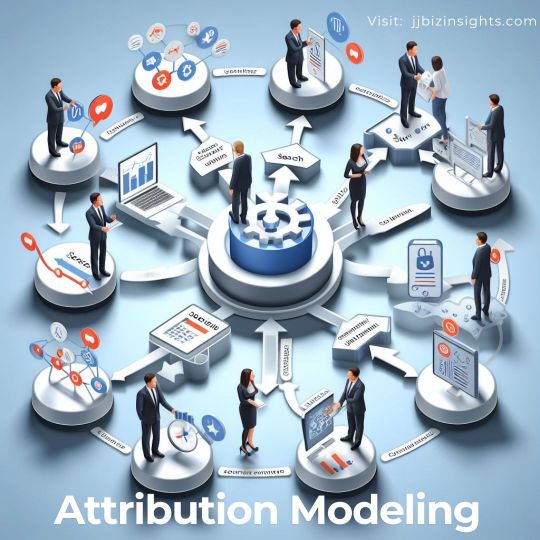

Liberate your Toes with Comfortable Shoe 20%OFF
Disclosure: This post may contain affiliate links. By clicking on a link and making a purchase, I may earn a commission at no additional cost to you.
2 notes
·
View notes
Text
Project Title:Cross-Platform E-commerce Revenue Attribution Modeling using Pandas, XGBoost, and Attribution Modeling Algorithms
Project Title:Cross-Platform E-commerce Revenue Attribution Modeling using Pandas, XGBoost, and Attribution Modeling AlgorithmsReference ID: ai-ml-ds-SrmZNuoOhMkFile Name: cross_platform_ecommerce_revenue_attribution_modeling.py Short Description: This project aims to develop an advanced, cross-platform e-commerce revenue attribution model. By leveraging Pandas for data manipulation, XGBoost…
0 notes
Text
Project Title:Cross-Platform E-commerce Revenue Attribution Modeling using Pandas, XGBoost, and Attribution Modeling Algorithms
Project Title:Cross-Platform E-commerce Revenue Attribution Modeling using Pandas, XGBoost, and Attribution Modeling AlgorithmsReference ID: ai-ml-ds-SrmZNuoOhMkFile Name: cross_platform_ecommerce_revenue_attribution_modeling.py Short Description: This project aims to develop an advanced, cross-platform e-commerce revenue attribution model. By leveraging Pandas for data manipulation, XGBoost…
0 notes
Text
Project Title:Cross-Platform E-commerce Revenue Attribution Modeling using Pandas, XGBoost, and Attribution Modeling Algorithms
Project Title:Cross-Platform E-commerce Revenue Attribution Modeling using Pandas, XGBoost, and Attribution Modeling AlgorithmsReference ID: ai-ml-ds-SrmZNuoOhMkFile Name: cross_platform_ecommerce_revenue_attribution_modeling.py Short Description: This project aims to develop an advanced, cross-platform e-commerce revenue attribution model. By leveraging Pandas for data manipulation, XGBoost…
0 notes
Text
Project Title:Cross-Platform E-commerce Revenue Attribution Modeling using Pandas, XGBoost, and Attribution Modeling Algorithms
Project Title:Cross-Platform E-commerce Revenue Attribution Modeling using Pandas, XGBoost, and Attribution Modeling AlgorithmsReference ID: ai-ml-ds-SrmZNuoOhMkFile Name: cross_platform_ecommerce_revenue_attribution_modeling.py Short Description: This project aims to develop an advanced, cross-platform e-commerce revenue attribution model. By leveraging Pandas for data manipulation, XGBoost…
0 notes
Text
Project Title:Cross-Platform E-commerce Revenue Attribution Modeling using Pandas, XGBoost, and Attribution Modeling Algorithms
Project Title:Cross-Platform E-commerce Revenue Attribution Modeling using Pandas, XGBoost, and Attribution Modeling AlgorithmsReference ID: ai-ml-ds-SrmZNuoOhMkFile Name: cross_platform_ecommerce_revenue_attribution_modeling.py Short Description: This project aims to develop an advanced, cross-platform e-commerce revenue attribution model. By leveraging Pandas for data manipulation, XGBoost…
0 notes
Text
🔍 Want to know what’s really driving your leads and conversions? At Qubit International, we connect the dots across your entire customer journey by integrating CRM platforms, GA4, and attribution tools—so you can make smarter marketing decisions that boost ROI. 🚀
📞 Call us: +61 485353862 📧 Email: [email protected] 🌐 Visit: https://qubit-international.com/2025/04/09/crm-ga4-attribution-integration/
#CustomerJourney#DigitalMarketingExperts#GA4Integration#CRMTools#AttributionModeling#MarketingROI#QubitInternational#SmartAnalytics#LeadTracking#ConversionOptimization#DataDrivenMarketing
0 notes
Text
A Beginner’s Guide to Channel Attribution Modeling in Marketing
Introduction
In a typical ‘from think to buy’ customer journey, a customer goes through multiple touch points before zeroing in on the final product to buy. This is even more prominent in the case of e-commerce sales. It is relatively easier to track which are the different touch points the customer has encountered before making the final purchase.
As marketing moves more and more towards the consumer driven side of things, identifying the right channels to target customers has become critical for companies. This helps companies optimise their marketing spend and target the right customers in the right places.
More often than not, companies usually invest in the last channel which customers encounter before making the final purchase. However, this may not always be the right approach. There are multiple channels preceding that channel which eventually drive the customer conversion. The underlying concept to study this behavior is known as ‘multi-channel attribution modeling.’
In this article, we look at what channel attribution is and how it ties into the concept of Markov chains. We’ll also take a case study of an e-commerce company to understand how this concept works, both theoretically and practically (using R).
Table of Contents
What is Channel Attribution?
Markov Chains
Removal Effect
Case Study of an E-Commerce Company
Implementation in R
What is Channel Attribution?
Google Analytics offers a standard set of rules for attribution modeling. As per Google, “An attribution model is the rule, or set of rules, that determines how credit for sales and conversions is assigned to touchpoints in conversion paths. For example, the Last Interaction model in Analytics assigns 100% credit to the final touchpoints (i.e., clicks) that immediately precede sales or conversions. In contrast, the First Interaction model assigns 100% credit to touchpoints that initiate conversion paths.”
We will see the last interaction model and first interaction model later in this article. Before that, let’s take a small example and understand channel attribution a little further. Let’s say we have a transition diagram as shown below:
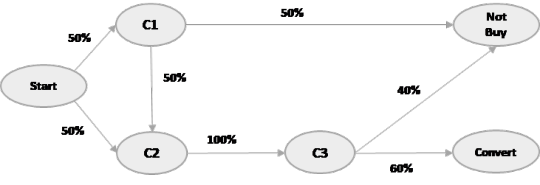
In the above scenario, a customer can either start their journey through channel ‘C1’ or channel ‘C2’. The probability of starting with either C1 or C2 is 50% (or 0.5) each. Let’s calculate the overall probability of conversion first and then go further to see the effect of each of the channels.
P(conversion) = P(C1 -> C2 -> C3 -> Conversion) + P(C2 -> C3 -> Conversion)
= 0.5*0.5*1*0.6 + 0.5*1*0.6 = 0.15 + 0.3 = 0.45
Markov Chains
Markov chains is a process which maps the movement and gives a probability distribution, for moving from one state to another state. A Markov Chain is defined by three properties:
State space – set of all the states in which process could potentially exist
Transition operator –the probability of moving from one state to other state
Current state probability distribution – probability distribution of being in any one of the states at the start of the process
We know the stages through which we can pass, the probability of moving from each of the paths and we know the current state. This looks similar to Markov chains, doesn’t it?
Removal Effect
This is, in fact, an application of a Markov chains. We will come back to this later; let’s stick to our example for now. If we were to figure out what is the contribution of channel 1 in our customer’s journey from start to end conversion, we will use the principle of removal effect. Removal effect principle says that if we want to find the contribution of each channel in the customer journey, we can do so by removing each channel and see how many conversions are happening without that channel being in place.
For example, let’s assume we have to calculate the contribution of channel C1. We will remove the channel C1 from the model and see how many conversions are happening without C1 in the picture, viz-a-viz total conversion when all the channels are intact. Let’s calculate for channel C1:
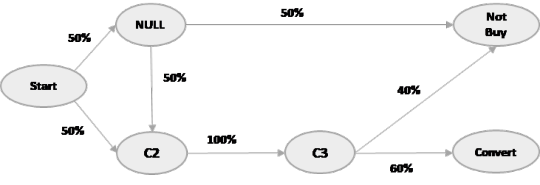
P(Conversion after removing C1) = P(C2 -> C3 -> Convert)
= 0.5*1*0.6
= 0.3
30% customer interactions can be converted without channel C1 being in place; while with C1 intact, 45% interactions can be converted. So, the removal effect of C1 is
0.3/0.45 = 0.666.
The removal effect of C2 and C3 is 1 (you may try calculating it, but think intuitively. If we were to remove either C2 or C3, will we be able to complete any conversion?).
This is a very useful application of Markov chains. In the above case, all the channels – C1, C2, C3 (at different stages) – are called transition states; while the probability of moving from one channel to another channel is called transition probability.
Customer journey, which is a sequence of channels, can be considered as a chain in a directed Markov graph where each vertex is a state (channel/touch-point), and each edge represents transition probability of moving from one state to another. Since the probability of reaching a state depends only on the previous state, it can be considered as a memory-less Markov chain.
Case Study of an E-Commerce Company
Let’s take a real-life case study and see how we can implement channel attribution modeling.
An e-commerce company conducted a survey and collected data from its customers. This can be considered as representative population. In the survey, the company collected data about the various touch points where customers visit before finally purchasing the product on its website.
In total, there are 19 channels where customers can encounter the product or the product advertisement. After the 19 channels, there are three more cases:
#20 – customer has decided which device to buy;
#21 – customer has made the final purchase, and;
#22 – customer hasn’t decided yet.
The overall categories of channels are as below:CategoryChannel Website (1,2,3) Company’s website or competitor’s website Research Reports (4,5,6,7,8) Industry Advisory Research Reports Online/Reviews (9,10) Organic Searches, Forums Price Comparison (11) Aggregators Friends (12,13) Social Network Expert (14) Expert online or offline Retail Stores (15,16,17) Physical Stores Misc. (18,19) Others such as Promotional Campaigns at various location
Now, we need to help the e-commerce company in identifying the right strategy for investing in marketing channels. Which channels should be focused on? Which channels should the company invest in? We’ll figure this out using R in the following section. To complement such advanced analytics, companies often engage AI consulting firms to integrate predictive capabilities into their business processes.
Implementation using R
Let’s move ahead and try the implementation in R and check the results. You can download the dataset here and follow along as we go. #Install the libraries install.packages("ChannelAttribution") install.packages("ggplot2") install.packages("reshape") install.packages("dplyr") install.packages("plyr") install.packages("reshape2") install.packages("markovchain") install.packages("plotly") #Load the libraries library("ChannelAttribution") library("ggplot2") library("reshape") library("dplyr") library("plyr") library("reshape2") library("markovchain") library("plotly") #Read the data into R > channel = read.csv("Channel_attribution.csv", header = T) > head(channel)
Output:R05A.01R05A.02R05A.03R05A.04…..R05A.18R05A.19R05A.20 16 4 3 5 NA NA NA 2 1 9 10 NA NA NA 9 13 20 16 NA NA NA 8 15 20 21 NA NA NA 16 9 13 20 NA NA NA 1 11 8 4 NA NA NA
We will do some data processing to bring it to a stage where we can use it as an input in the model. Then, we will identify which customer journeys have gone to the final conversion (in our case, all the journeys have reached final conversion state).
We will create a variable ‘path’ in a specific format which can be fed as an input to the model. Also, we will find out the total occurrences of each path using the ‘dplyr’ package. > for(row in 1:nrow(channel)) { if(21 %in% channel[row,]){channel$convert[row] = 1} } > column = colnames(channel) > channel$path = do.call(paste, c(channel[column], sep = " > ")) > head(channel$path) [1] "16 > 4 > 3 > 5 > 10 > 8 > 6 > 8 > 13 > 20 > 21 > NA > NA > NA > NA > NA > NA > NA > NA > NA > NA > 1" [2] "2 > 1 > 9 > 10 > 1 > 4 > 3 > 21 > NA > NA > NA > NA > NA > NA > NA > NA > NA > NA > NA > NA > NA > 1" [3] "9 > 13 > 20 > 16 > 15 > 21 > NA > NA > NA > NA > NA > NA > NA > NA > NA > NA > NA > NA > NA > NA > NA > 1" [4] "8 > 15 > 20 > 21 > NA > NA > NA > NA > NA > NA > NA > NA > NA > NA > NA > NA > NA > NA > NA > NA > NA > 1" [5] "16 > 9 > 13 > 20 > 21 > NA > NA > NA > NA > NA > NA > NA > NA > NA > NA > NA > NA > NA > NA > NA > NA > 1" [6] "1 > 11 > 8 > 4 > 9 > 21 > NA > NA > NA > NA > NA > NA > NA > NA > NA > NA > NA > NA > NA > NA > NA > 1" > for(row in 1:nrow(channel)) { channel$path[row] = strsplit(channel$path[row], " > 21")[[1]][1] } > channel_fin = channel[,c(23,22)] > channel_fin = ddply(channel_fin,~path,summarise, conversion= sum(convert)) > head(channel_fin)
Output:pathconversion 1 > 1 > 1 > 20 1 1 > 1 > 12 > 12 1 1 > 1 > 14 > 13 > 12 > 20 1 1 > 1 > 3 > 13 > 3 > 20 1 1 > 1 > 3 > 17 > 17 1 > 1 > 6 > 1 > 12 > 20 > 12 1 > Data = channel_fin > head(Data)
Output:pathconversion 1 > 1 > 1 > 20 1 1 > 1 > 12 > 12 1 1 > 1 > 14 > 13 > 12 > 20 1 1 > 1 > 3 > 13 > 3 > 20 1 1 > 1 > 3 > 17 > 17 1 1 > 1 > 6 > 1 > 12 > 20 > 12 1
Now, we will create a heuristic model and a Markov model, combine the two, and then check the final results. > H <- heuristic_models(Data, 'path', 'conversion', var_value='conversion') > H
Output:channel_namefirst_touch_conversions…..linear_touch_conversionslinear_touch_value 1 130 73.773661 73.773661 20 0 473.998171 473.998171 12 75 76.127863 76.127863 14 34 56.335744 56.335744 13 320 204.039552 204.039552 3 168 117.609677 117.609677 17 31 76.583847 76.583847 6 50 54.707124 54.707124 8 56 53.677862 53.677862 10 547 211.822393 211.822393 11 66 107.109048 107.109048 16 111 156.049086 156.049086 2 199 94.111668 94.111668 4 231 250.784033 250.784033 7 26 33.435991 33.435991 5 62 74.900402 74.900402 9 250 194.07169 194.07169 15 22 65.159225 65.159225 18 4 5.026587 5.026587 19 10 12.676375 12.676375 > M <- markov_model(Data, 'path', 'conversion', var_value='conversion', order = 1)> M
Output:channel_nametotal_conversiontotal_conversion_value 1 82.482961 82.482961 20 432.40615 432.40615 12 83.942587 83.942587 14 63.08676 63.08676 13 195.751556 195.751556 3 122.973752 122.973752 17 83.866724 83.866724 6 63.280828 63.280828 8 61.016115 61.016115 10 209.035208 209.035208 11 118.563707 118.563707 16 158.692238 158.692238 2 98.067199 98.067199 4 223.709091 223.709091 7 41.919248 41.919248 5 81.865473 81.865473 9 179.483376 179.483376 15 70.360777 70.360777 18 5.950827 5.950827 19 15.545424 15.545424
Before going further, let’s first understand what a few of the terms we’ve seen above mean.
First Touch Conversion: The conversion happening through the channel when that channel is the first touch point for a customer. 100% credit is given to the first touch point.
Last Touch Conversion: The conversion happening through the channel when that channel is the last touch point for a customer. 100% credit is given to the last touch point.
Linear Touch Conversion: All channels/touch points are given equal credit in the conversion.
Getting back to the R code, let’s merge the two models and represent the output in a visually appealing manner which is easier to understand. # Merges the two data frames on the "channel_name" column. R <- merge(H, M, by='channel_name') # Select only relevant columns R1 <- R[, (colnames(R) %in %c('channel_name', 'first_touch_conversions', 'last_touch_conversions', 'linear_touch_conversions', 'total_conversion'))] # Transforms the dataset into a data frame that ggplot2 can use to plot the outcomes R1 <- melt(R1, id='channel_name') # Plot the total conversions ggplot(R1, aes(channel_name, value, fill = variable)) + geom_bar(stat='identity', position='dodge') + ggtitle('TOTAL CONVERSIONS') + theme(axis.title.x = element_text(vjust = -2)) + theme(axis.title.y = element_text(vjust = +2)) + theme(title = element_text(size = 16)) + theme(plot.title=element_text(size = 20)) + ylab("")
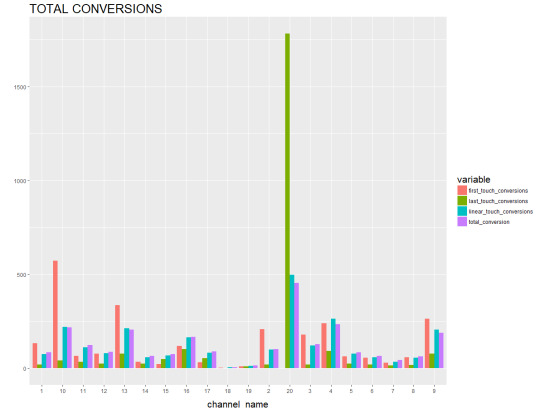
The scenario is clearly visible from the above graph. From the first touch conversion perspective, channel 10, channel 13, channel 2, channel 4 and channel 9 are quite important; while from the last touch perspective, channel 20 is the most important (in our case, it should be because the customer has decided which product to buy). In terms of linear touch conversion, channel 20, channel 4 and channel 9 are coming out to be important. From the total conversions perspective, channel 10, 13, 20, 4 and 9 are quite important.
End Notes
In the above chart we have been able to figure out which are the important channels for us to focus on and which can be discarded or ignored. This case gives us a very good insight into the application of Markov chain models in the customer analytics space. E-commerce companies can now confidently create their marketing strategy and distribute their marketing budget using data driven insights. Our team of experienced AI consulting firms can assist you in transforming these insights into impactful business outcomes.
Read more: Tableau Sales Dashboard Performance | Anomaly Detection | Text Mining Tips | Machine Learning with SVM
1 note
·
View note
Text
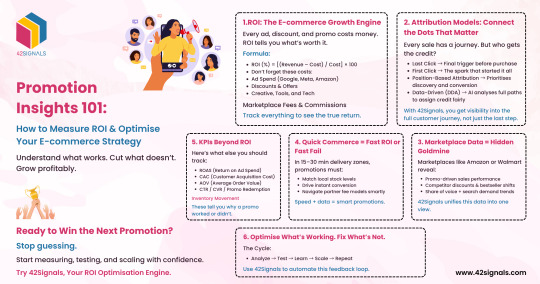
📊 Promotion Insights 101: Your E-commerce ROI Playbook
Running ads, offering discounts, pushing promos… but still wondering what actually worked?
This one-scroll infographic breaks it all down: → Real ROI calculation (not just vanity metrics) → Attribution models that tell the full story → Marketplace + quick commerce data that fuels smarter campaigns → KPIs that actually matter
💡 It's not just about running promotions. It's about profitable growth, powered by 42Signals.
🔗 https://tinyurl.com/49prhzmf
#ecommerce#roi#marketingstrategy#promotioninsights#digitalcommerce#growthmarketing#attributionmodels#42signals
0 notes
Text
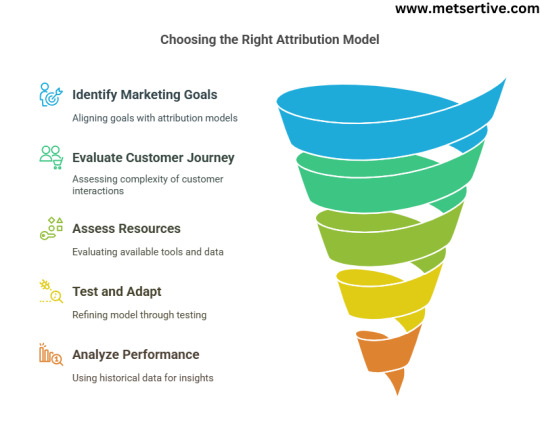
Marketing Attribution Could Save Your Business… If You Pick the Right One
Most businesses think "more ads = more sales." ❌ Reality Check: If you're tracking the wrong touchpoints, you're burning $$$ every single day.
Choosing the right marketing attribution model means:
✅ Smarter marketing decisions ✅ Bigger ROIs ✅ No more guessing where your customers really come from
Ignoring attribution? 👀 You’ll keep funding "zombie channels" that aren’t moving the needle.
Want to know how to finally connect the dots between your marketing and your revenue?
#Marketingattribution#Attributionmodel#Customerjourney#MarketingOptimization#MarketingAnalytics#MarketingROI#GrowthMarketing#MarketingInsights#MarketingTrend#DataDrivenMarketing
0 notes
Text
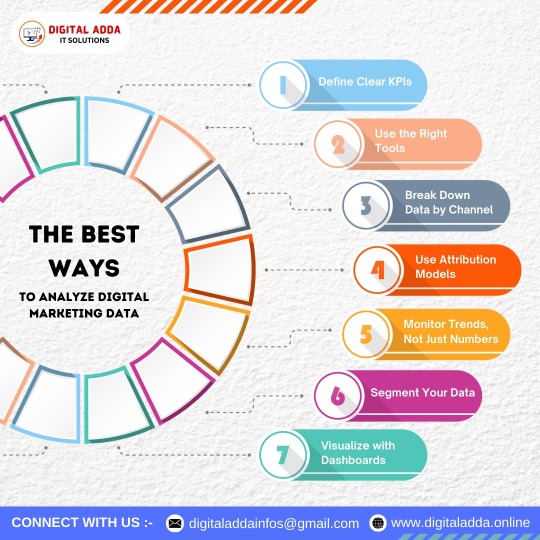
📊 Want to make smarter marketing decisions? Start by analyzing your data the right way! Here are the 7 Best Ways to Analyze Digital Marketing Data like a pro:
1️⃣ Define Clear KPIs 2️⃣ Use the Right Tools 3️⃣ Break Down Data by Channel 4️⃣ Use Attribution Models 5️⃣ Monitor Trends, Not Just Numbers 6️⃣ Segment Your Data 7️⃣ Visualize with Dashboards
✨ Turn raw data into actionable insights and watch your strategy skyrocket!
💡 Follow us for more digital marketing tips! 📩 Need help with your digital growth? DM us or contact: [email protected] 🌐 www.digitaladda.online
#DigitalMarketingTips #DataAnalytics #MarketingStrategy #KPI #AttributionModels #MarketingInsights #DigitalAdda #MarketingTools #BusinessGrowth #SocialMediaMarketing #DigitalMarketingExperts #MarketingDashboard #MarketingTrends
0 notes
Text
Unraveling Marketing Analytics: Insights, Tools, & Its Significance
Originally Published on: QuantzigWhat are Marketing Analytics? Tips, Tools, & Why It Matters
In the dynamic realm of sports marketing, assessing the effectiveness and success of marketing endeavors is crucial. Marketers in this field face challenges and leverage consumer insights to shape impactful marketing objectives. The correlation between return on investment (ROI) and brand recognition, coupled with conversions, underscores the imperative need for employing advanced models such as Media Mix Models (MMM), Multi-Touch Attribution (MTA), and Unified Marketing Measurement (UMM). #SportsMarketing #ConsumerInsights
Importance of Marketing Analytics:
Chief Marketing Officers (CMOs) heavily rely on Return on Marketing Investment (ROMI) as a pivotal metric for optimizing marketing initiatives. In today’s complex market landscape, where digital and physical channels offer a plethora of options, CMOs strive to devise adaptable strategies to effectively engage customers. Through an integrated marketing framework, CMOs can strategically allocate budgets across diverse channels, ensuring resource optimization and fostering tactical flexibility. This harmonious integration of long-term strategy and real-time responsiveness enhances a brand’s adaptability and prosperity. #ROMI #IntegratedMarketing
Challenges in Marketing Analytics:
In the contemporary marketing sphere, data streams from various sources, each with unique characteristics, pose a significant challenge. Advanced analytical services and machine learning solutions play a crucial role in assimilating heterogeneous data into a cohesive strategy. These tools sift through data to extract meaningful insights, enabling informed decision-making and prudent resource allocation. However, managing extensive data volumes presents challenges, underscoring the importance of data analysis and quality. Attribution models and analytical software provide real-time insights, guiding annual media plan recommendations and ensuring a comprehensive marketing mix. #DataIntegration #AttributionModels
Benefits of Implementing Analytics in Marketing:
Quantzig’s Unified Marketing Decision Management (MDM) framework offers a holistic approach to advertising optimization. Beginning with the measurement and attribution of marketing spending, it furnishes insights into the efficacy of various promotions and optimizes resource allocation. The framework establishes effective spending parameters for each channel, preventing overspending and optimizing resource utilization. By quantifying the impact of advertising activities, MDM facilitates the optimization of marketing endeavors, enhancing decision-making and driving success. #MDMFramework #AdvertisingOptimization
Conclusion:
In the era of data-driven operations, marketing analytics emerges as a guiding beacon for businesses striving for success. Understanding consumer behavior, evaluating campaign performance, and refining strategies are pivotal for thriving in the ever-evolving marketing landscape. Those adept at harnessing the capabilities of market analytical services will excel in the quest for market dominance. Embrace insights, empower decisions, and witness your brand ascend to unprecedented heights in the epoch of data-driven marketing
Contact us.
0 notes
Text

"🚀 Ready to start your digital transformation journey? 🌟
Partner with trusted experts to guide you on the path to success. 👥💼 #DigitalTransformation #ExpertGuidance 💻
For more info,
🛑 🖥Visit: https://dmarketic.com/
🛑 📧Email: [email protected]
🛑 📞Call: +971 55 377 0615
.
.
.
#digitalmarketingROI
#marketinganalytics
#marketingROI
#ROItracking
#conversiontracking
#attributionmodeling
#marketingmetrics
#marketingKPIs
#ROIreporting"
#digitalmarketingROI#marketinganalytics#marketingROI#ROItracking#conversiontracking#attributionmodeling#marketingmetrics#marketingKPIs#ROIreporting"
0 notes
Link
Attribution models are important for marketers as it helps them understand their customer’s journey, and provide an analysis on the perfect time to invest in marketing campaigns. Hence, they should know which attribution model should be used to track data.
0 notes
Photo





From get-go to full gear stage, our collaboration with a revolutionary educational platform was centred around capturing their core essence. An in-depth discussion and understanding of their ideology - 'paving way for enterprising young minds,' helped us give rise to the brand name, EMERGE. From there, every design element and communication channel was an extension of this bubbling brand identity with vibrant hues and bold illustrations adding on to the impact it created. Get a deeper insight into our project and works through the link : www.madarth.com/work/
#Madarth#HomeGrownWorldClass#Branding#Designing#Digital#Emerge#EducationalPlatform#LogoDesign#BrandNaming#BrandIdentity#IndianBrands#BrandingInIndia#BrandStrategy#AttributionModel#DigitalMediaMarketing#StrategicPlanning#StrategicCommunication#StrategicMarketing
0 notes
Photo

Google Ads Attribution Models Explained and Attribution Reports in Google Analytics http://ehelpdesk.tk/wp-content/uploads/2020/02/logo-header.png [ad_1] Check out our video about Google... #affiliatemarketing #attributiongoogleanalytics #attributionmodel #attributionmodelinggoogleanalytics #attributionmodels #attributionmodelsgoogleanalytics #businessbranding #contentmarketing #copywriting #datadrivenattributionmodel #digitalmarketing #facebookmarketing #google #googleads #googleadsattribution #googleadsattributionmodel #googleadsattributionmodels #googleadsattributionreport #googleadsconversionmodels #googleadwordsattribution #googleadwordsattributionmodels #googleanalytics #googleanalyticsattributions #instagrammarketing #lastclickattributionmodel #marketing #marketingstrategy #ppcadvertising #seo #socialmediamarketing #youtubeaudiencegrowth #youtubemarketing
0 notes